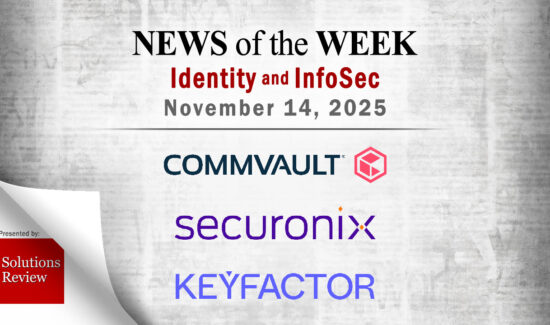Identity Management Day Quotes from Industry Experts in 2025

For Identity Management Day 2025, the editors at Solutions Review have compiled a list of quotes and commentary from some of the field’s leading experts. These comments originally appeared in Insight Jam, an enterprise IT community that enables human conversation on AI.
As part of Identity Management Day 2025, the Solutions Review editorial team called for the industry’s best and brightest to share their insights, predictions, and commentary on the evolving world of Identity Management technology. The experts featured represent some of the top Cybersecurity solution providers with experience in the marketplace, and each projection has been vetted for relevance and ability to add business value. The list is organized alphabetically by associated company name.
Identity Management Day Quotes from Industry Experts in 2025
Rom Carmel, Co-Founder and CEO of Apono
“This Identity Management Day, let’s spotlight the evolving role of identity security in an increasingly digital and AI-driven world. With remote work, cloud adoption, and digital transformation accelerating, organizations face mounting challenges in managing access to sensitive data and systems.
“Emerging technologies like zero trust architecture, decentralized identity, passwordless authentication, and AI-driven security are reshaping identity management. In particular, Large Language Models (LLMs) and AI-powered automation are transforming how organizations make access decisions—analyzing vast amounts of data in real-time to detect anomalies, enforce least privilege, and streamline identity governance.
“By embracing cloud-based identity and access management (IAM) and leveraging AI for dynamic, context-aware access control, organizations can strengthen security, enhance efficiency, and maintain compliance—without adding friction to user experiences. Identity is the foundation of cybersecurity. By prioritizing AI-driven innovation and proactive security, we can build a resilient, adaptive digital future for all.”
Ofer Friedman, Chief Business Development Officer, AU10TIX
“Effective identity management requires effectiveness of the initial process that grants people access to organizations, services, and resources. If a bad actor successfully sneaks in, then from that point on, that person is trusted by any AIM platform. Nobody wants to let trojan horses in, even if they do not misbehave immediately. But not all identity verification services are born equal, even if, on the outside, they seem to be performing similar actions. In other words, effective identity management starts with making sure that the right people are verified and entitled to access. In 2025, an effective identity verification service must be built with paranoia. It’s no longer about Identity Verification; it is about Identity Risk.”
Greg Wetmore, Vice President of Product Development at Entrust
“The latest advancements in quantum computing chips have brought the technology to the forefront of business leaders’ minds. However, while quantum computing promises significant breakthroughs, it will also introduce an entirely new set of threats. At the heart of this challenge is the risk to digital identities and confidential information. A fully scaled quantum computer will have the capability to break current cryptographic methods widely used to protect our increasingly digital lives. Organizations must prepare for the emerging risks associated with post-quantum cryptography and take the necessary steps to ensure that identities and other sensitive data remain secure.”
Joel Burleson‑Davis, Senior Vice President of Engineering, Cyber at Imprivata
“In today’s landscape, cyber incidents are growing, often due to third-party access, and are disrupting both personal and organizational identities. A recent survey revealed that the most significant consequences of these attacks are the loss of sensitive data, regulatory fines, and severed vendor relationships. With nearly half of organizations experiencing such incidents in the past year and expectations for these threats to continue rising, effective identity management has never been more crucial.
“To safeguard both human and non-human identities, organizations must focus on strategic identity management. Solutions like biometrics and MFA can enhance security, but they must be implemented in a way that doesn’t disrupt operations or impede productivity. The journey to better identity management requires balancing security with seamless user experiences across all digital and human touchpoints.”
Darren Guccione, CEO and Co-Founder of Keeper Security
“As technology continues to advance and identity becomes more complex than ever, IT leaders must implement a multi-layered approach to security that addresses the most prevalent existing threats and combats the malicious cyber weapons of the future. Cyber-criminals are becoming increasingly sophisticated, leveraging AI to increase the volume and severity of their attacks. Recent research reveals that more than 50 percent of IT and security leaders have witnessed AI-powered attacks first-hand at their organization, and 36 percent have seen deepfake technology, spotlighting the precipitous rise of these technologically advanced threats.
“Identity Management Day is a timely reminder that although threats continue to evolve, following fundamental cybersecurity best practices remains the most effective method to stay protected against both existing and emerging attack vectors. With privileged accounts being a primary target for cyber-criminals, implementing a robust Privileged Access Management (PAM) solution is essential. Verizon’s Data Breach Investigations Report revealed that 80 percent of organizations that adopted PAM solutions reported a significant reduction in successful cyber-attacks related to credential theft and misuse, underscoring the criticality of deploying PAM solutions.”
Nick Kathmann, Chief Information Security Officer at LogicGate
High-Profile Security Lapses Highlight The Human Element Of Identity
“Identity remains one of the weakest links in any security ecosystem. Even the most secure solution can fall victim to human error. It’s tempting to blame the service, but even when a platform is highly secure, the real issue is a lack of stringent identity security processes. Simple measures like identity validation can prevent sensitive information from getting out. Limiting risk goes beyond MFA; continuous identity and permission monitoring are critical. This includes location, behavior-based validation as well as clearly defined identity validation for account management actions, along with consistent security training for everyone from the shop floor to the C-suite. At the end of the day, technology is only as useful as its users. If your endpoint isn’t secure, even the strongest security solutions are reachable.”
Kris Bondi, CEO and Co-founder, Mimoto
“The concept of identity is at an inflection point where it will explode into multiple areas. Today, most people still consider identity to be synonymous with a credential or authorized person. That is quickly changing.
“Organizations are realizing the adherent danger in this assumption. According to the IBM data loss prevention report, 95 percent of malicious activity has a human element. We see this illustrated with the increase in compromised credentials, deepfakes, account takeovers, and internal malicious activity that is missed or, the opposite, a tidal wave of false positive alerts.
“I predict two changes we’ll see before the Identity Management Day 2026. First, the nuance of the term identity will become widely used. For example, machine-to-machine identity management, workload identities, and person-based identity are all terms used in some DevOps or SOCs that will become more widely understood and used. Second, instead of focusing on protecting ‘identities,’ aka credentials, highly accurate person-based credentials will be used to identify malicious activity in real-time with an understanding of context that hasn’t been possible until now. It is the difference between there is something to investigate with Jack’s account, or, Jane is using Jack’s credentials to access financial systems that she isn’t approved to view.”
Marta Dern, Senior Product Marketing Manager at Oasis Security
“Don’t overlook your newest identity risk, Artificial Intelligence (AI) agents. At first glance, AI agents might seem like just another tool, handling IT support, optimizing cloud costs, answering customer questions, and even making decisions. But unlike human employees, AI agents don’t think or reason. They act based on algorithms and data, not intent or intuition.
“They don’t log in with usernames and passwords. They authenticate using API keys, managed identities, and machine-to-machine protocols. Unless explicitly programmed to follow your security policies, they often don’t. Left unchecked, AI agents can create new identities, generate access credentials, and grant themselves privileged permissions without alerting anyone. Over time, this leads to identity sprawl and uncontrolled access to critical systems.
“This Identity Management Day is a reminder that identity is more than human. AI agents are non-human identities, and they need to be secured with the same rigor. That means real-time visibility, automated lifecycle management, and guardrails that prevent privilege abuse.”
Will LaSala, Field CTO at OneSpan
“Identity Management Day serves as a crucial reminder to prioritize secure authentication methods to safeguard digital identities. As digital transactions continue to outpace traditional methods, online identity fraud now accounts for over 70 percent of all incidents. To better protect users, both businesses and individuals must adopt stringent identity verification (IDV) strategies. The future lies in leveraging robust multi-factor authentication (MFA) solutions, such as FIDO passkeys, alongside Bring Your Own Identity (BYOI)—a model where users can authenticate through their preferred identity provider (IdP), offering more flexibility and control.”
“BYOI empowers users to leverage the identity systems they trust—whether social logins, corporate credentials, or decentralized identity systems—while maintaining strong security. This user-centric approach meets the growing demand for flexible identity management, allowing individuals to choose their preferred authentication method while ensuring their personal data remains protected. However, it is critical to ensure that the provisioning of these identities is secure, as only then can we fully trust the authentication request.
“As digital identity threats continue to evolve, adopting a comprehensive identity verification (IDV) strategy that incorporates both secure BYOI and robust MFA like FIDO passkeys offers a resilient defense for users and businesses alike. This approach not only ensures a seamless and secure experience but also strengthens the overall integrity of the authentication process, providing trust from start to finish.”
Piyush Pandey, CEO of Pathlock
“Identity Management Day is a reminder that the conversation around identity has changed fundamentally. For decades, traditional identity governance has been primarily focused on driving operational efficiencies through identity lifecycle management, which addresses the joiner-mover-leaver model. However, amid rapid digitalization, this approach has started to fall short, as reality dictates its own terms—with access risks continuously emerging in the myriads of business applications as user roles change throughout their careers.
“Our highest-risk, regulated business processes are no longer effectively controlled. Traditional identity frameworks simply can’t keep up with today’s dynamic risk landscape. Potential negative consequences of overlooking these identity-related risks include excessive access, data breaches, compliance failures, and corporate fraud.
“Identity security for high-risk applications must now focus on compliant provisioning and continuous controls monitoring. It’s not just about ensuring the right people have the right access at the right time—it’s about proactively preventing internal fraud, audit failures, and reputational damage while responding to risks in real-time. While automating audits saves time and money, securing identity access today must go well beyond compliance.”
Patrick Harding, Chief Product Architect, Ping Identity
“Identity Management Day takes on a whole new meaning this year as individuals and organizations find themselves not only responsible for managing human identities but also increasingly tasked with overseeing AI, as it assumes agentic roles on behalf of humans. The impact AI will have on identity is far greater than we anticipate. For that reason, it’s important for businesses and individuals to ensure their security practices keep pace with the rapid evolution of technologies like AI.
“Leaning into approaches like zero trust architectures and decentralized identity models is that much more critical in a digital-first world. As AI attacks target centralized repositories of personal data and look to mimic trusted users, it’s imperative to ensure data isn’t gathered in one vulnerable location and every user is verified, regardless of who they are or claim to be. As the way we work changes, it’s critical we secure our workforce, build customer trust, and deliver the seamless and secure digital experiences individuals deserve.”
Roy Akerman, Head of Cloud and Identity Security at Silverfort
“A complete identity security solution is no longer a nice to have, it’s a need to have. With the use of AI, malicious actors are generating hyper-realistic deepfakes and sophisticated phishing campaigns, allowing them to steal credentials, assume digital identities, and bypass security measures undetected. Leaving credentials exposed and putting defenders in a constant battle to assess control and contain potential misuse—before it becomes one of the 80 percent of breaches caused by compromised identities.
“Advanced AI and deepfake technology make visibility key to defending against identity-based threats. Organizations must move beyond traditional identity controls, such as multi-factor authentication (MFA), and adopt a unified, end-to-end identity security approach. Extending security controls across an organization’s entire identity infrastructure will give security teams the visibility needed to detect unauthorized access attempts and the tools necessary to stop a breach before an attacker can spread laterally.
“Protecting identities must be a priority every day, not just on Identity Management Day. As threat actors innovate with AI and deepfakes become the norm, organizations must take proactive steps to reevaluate their identity security strategies and dedicate the time and resources necessary to protect every identity—in the cloud or on-premises, human or machine—because in today’s evolving threat landscape, identity security is the make or break.”
Mark Wojtasiak, VP Product Research & Strategy at Vectra AI
“Attackers are increasingly abusing identities to launch and spread attacks, with 90 percent of organizations experiencing identity-related breaches in the past year. Because traditional security tools like multi-factor authentication (MFA) are no longer enough to prevent these attacks, it’s critical for security teams to focus on detecting ever-evolving and emerging attacker methods that target both human and machine identities, from network to cloud. With that said, the growing sophistication of hybrid attacks demands the use of AI-powered tools for real-time, behavior-based detection to combat cyber-crime tactics such as phishing-as-a-service (PhaaS) and ransomware-as-a-service (RaaS) models.
“Fortunately, 89 percent of Security Operations Center (SOC) teams plan to integrate more AI in the coming year to replace outdated threat detection methods. Organizations can strengthen their defenses by using this technology to fortify their identity defenses and know when attackers have compromised an account or abused privilege. As attackers continue to gain access through logging in rather than traditional hacking methods, it’s crucial for SOC teams to detect and identify active threats exploiting identities to properly defend their modern network against today’s modern attacks.”
Alex Quilici, CEO of YouMail
“This Identity Management Day, be skeptical, not scared. By now, your identity is already out there. Your phone number, job title, connections, and even your social security number are all publicly available. The genie is out of the bottle, and pretending otherwise only puts you at greater risk.
“The question isn’t how to hide your identity. It’s how to operate safely in a world where your personal and professional information is already exposed. Assume attackers know more than they should. They’re using publicly available data to impersonate company leaders, target employees, and launch social engineering campaigns that feel alarmingly real. Add in voice cloning and AI-generated deepfakes, and the risk multiplies fast.
“Your personal cell phone is often the softest target. It’s the entry point for malware, impersonation attempts, and data exfiltration. And when that device blurs the line between work and personal life, it becomes even more dangerous. This is where tools make a difference. They not only block suspicious calls or scan for anomalies but also give you visibility into what’s being exposed and how it’s being used. The goal isn’t to lock down every piece of information—that’s no longer realistic—but to reduce the blast radius when something goes wrong.
“Stop chasing perfect privacy and focus instead on proactive protection. That means using technology to monitor for threats, automating offboarding to close access gaps, reassigning ownership, rotating credentials, and putting guardrails in place to detect unusual activity early.”





















